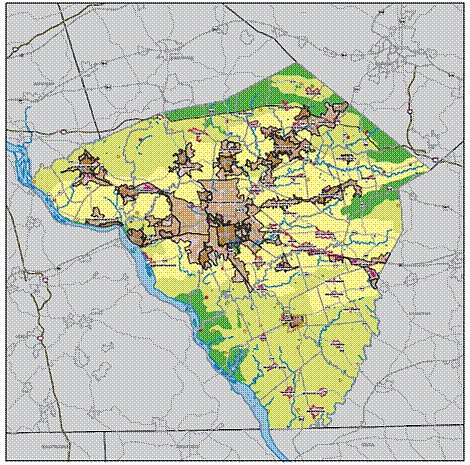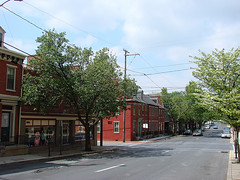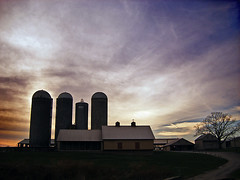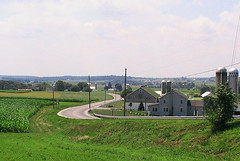Lancaster County has a stellar comprehensive plan: now to implementation

Posted December 7, 2009 at 1:28PM
This is one of a series of posts on the winners of EPA’s 2009 National Awards for Smart Growth Achievement.
Lancaster County, Pennsylvania, is a place of immense cultural importance, agricultural production and scenic beauty. The National Trust for Historic Preservation has described it eloquently:
“Famed as a center of ‘Pennsylvania Dutch’ culture because of its population of Amish, Mennonites and other plain religious sects, Lancaster County is a place where farming is still a way of life, where small-town America still thrives, and where residents cherish a strong sense of community. Long known as the ‘Garden Spot of America’ for its lushly productive farmland, the county also boasts a stable industrial base and a strong traditional character largely defined by the early settlers, predominantly of German, Scots-Irish and Welsh ancestry, who flocked here in the 18th and 19th centuries.”
National Geographic Traveler named Lancaster one of the 109 most important historic places on the planet.
The County is also, however, a place much threatened by sprawl. Listed as one of the nation’s most endangered historic places in 1999 and still considered endangered by the Trust, Lancaster’s picturesque character is quickly being overrun by “strip malls, fast-food restaurants [and] suburban housing developments.” According to a member of National Geographic Traveler’s jury, the county has already “ceased to be a distinctive cultural landscape. The Amish are lost amid the sprawl and schlock." (For a very good, relatively recent article on Lancaster sprawl, see Jennifer Vogelsong’s story in the York (PA) Daily Record.) This is an important place sorely in need of good, effective planning.
Fortunately, EPA’s smart growth office believes that effective planning is exactly what the county is getting from Envision Lancaster County, its comprehensive plan and the agency’s 2009 national award winner for “overall excellence” in smart growth.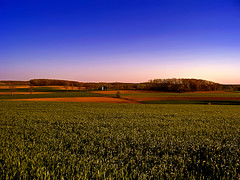 EPA’s citation notes that the plan directs new development to 47 urban and village growth areas in existing communities in order to spare the farmland, rural areas, and natural landscapes that define the county's character. The plan also, says EPA, promotes reinvestment in the county’s cities and towns and encourages more compact, interconnected neighborhoods while preserving open space, protecting water resources, and providing for greater housing and transportation choices. EPA reports that, in the city of Lancaster alone, 62 development projects have so far been completed or planned for development in designated growth areas.
EPA’s citation notes that the plan directs new development to 47 urban and village growth areas in existing communities in order to spare the farmland, rural areas, and natural landscapes that define the county's character. The plan also, says EPA, promotes reinvestment in the county’s cities and towns and encourages more compact, interconnected neighborhoods while preserving open space, protecting water resources, and providing for greater housing and transportation choices. EPA reports that, in the city of Lancaster alone, 62 development projects have so far been completed or planned for development in designated growth areas.
The planning process surveyed the county’s residents and found that, while they were pleased with progress in open space and farmland conservation, and with reconstruction of the county’s main highway, they also had significant concerns, some directly concerned with sprawl and growth:
- Traffic congestion and lack of road improvements – “A continuing trend of steadily decreasing transit ridership and an increase in the daily vehicle miles traveled has contributed to road congestion — a problem that is likely to worsen with increases in population and suburban sprawl.”
- Loss of farmland and overdevelopment – “Many commented that the construction of big-box retailers has increased traffic congestion and has caused the loss of small businesses.”
- Deterioration of Lancaster City – “A declining tax base, closing of downtown businesses, loss of historic resources, and crime were uppermost in the minds of respondents.”
Envision Lancaster County’s “growth management element” projects that the county will need to accommodate some 53,000 new homes between 2005 and 2030, but that the designated growth areas (see map above) are sufficient to do so “if the plan is fully implemented.” It specifically directs that a minimum of 85 percent of new growth be directed to the designated areas, and that the urban areas achieve a density of 7.5 units per acre, while the village areas achieve a density of 2.5 units per acre. I did not delve sufficiently deep into the 248-page growth management element to see how these targets were selected or how they compare with current trends. The village target seems low to me if it is intended to describe the net density of new residential growth; but, if it is intended to describe the density of areas as a whole after new growth is accommodated, it could represent significant achievement.
These are laudable goals. But the “if” noted above could turn out to be a biggie, because adherence to the plan by the county’s patchwork of 60 (!) municipalities (see map below) is entirely voluntary. There is certainly reason to be concerned, given not-too-distant history in the county. Two years ago, for example, the voters in East Hempfield Township forced their municipal supervisors to rescind an attempt to curb sprawl through a traditional neighborhood development ordinance promoting compact development.
Two years ago, for example, the voters in East Hempfield Township forced their municipal supervisors to rescind an attempt to curb sprawl through a traditional neighborhood development ordinance promoting compact development.
Unfortunately, the history of land use in the US is largely one of good plans being overridden by bad ad hoc development, approved by bad ad hoc decisionmaking. This is a major reason why the work in Ontario for the area around Toronto, backed by legal authority, remains the gold standard for planning on the continent, and why the process mandated by California’s smart growth law (SB375), which also has compliance mechanisms, is particularly promising in this country.
Notwithstanding East Hempfield, a positive sign in Lancaster’s case may be the county’s impressive track record in preserving farmland through easements, transfer of development rights, and agricultural zoning. The University of Pennsylvania’s Tom Daniels, former director of the county’s agriculture preserve board, reports in the August/September (2009) issue of Planning that the county has preserved over 80,000 acres, which would move Lancaster ahead of Montgomery County, Maryland, as the country’s largest farm preservation effort.
(There are some discrepancies in the reported acreage: EPA’s citation also reports over 80,000 acres saved in Lancaster, but Envision Lancaster County says that “approximately 30,000 acres of prime farmland have been permanently preserved.” The county’s Agricultural Preserve Board says, “as of November 18, 2009, the Agricultural Preserve Board has preserved 64,506 acres of farmland on 745 Lancaster County family farms.” Whatever the precise facts, this is a large and commendable effort. More on Lancaster’s agricultural preservation in a future post.)
We can also take some encouragement from all the work that the planning commission has done along the way in fashioning the comprehensive plan. Says EPA, “throughout the process, the commission actively engaged the public and local governments. The county's good working relationship with municipalities encouraged them to buy into the plan's principles.”
While we await the results on the ground, Envision Lancaster County gives us some excellent, thorough, principled planning, and a terrific vision to applaud and root for.


